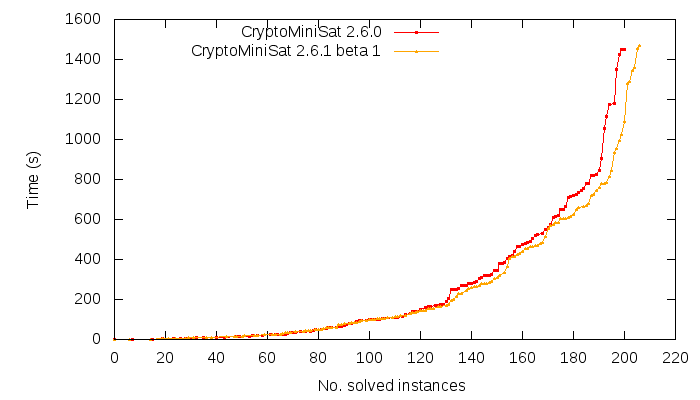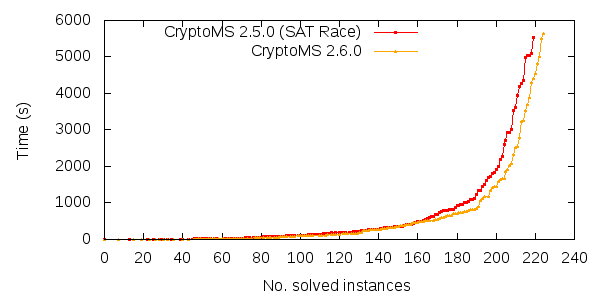Learnt clauses are clauses derived while searching for a solution with a SAT solver in a CNF. They are at the heart of every modern so-called “CDCL” or “Conflict-Driven Clause-Learning” SAT solver. SAT solver writers make a very important difference between learnt and original clauses. In this blog post I’ll talk a little bit about this distinction, why it is important to make it, and why we might want to relax that distinction in the future.
A bit of terminology
First, let me call “learnt” clauses “reducible” and original clauses “irreducible”. This terminology was invented by Armin Biere I believe, and it is conceptually very important.
If a clause is irreducible it means that if I remove that clause from the clause database and solve the remaining system of constraints, I might end up with a solution that is not a solution to the original problem. However, these clauses might not be the “original” clauses — they might have been shortened, changed, or otherwise manipulated such as through equivalent literal replacement, strengthening, etc.
Reducible clauses on the other hand are clauses that I can freely remove from the clause database without the risk of finding a solution that doesn’t satisfy the original set of constraints. These clauses could be called “learnt” but strictly speaking they might not have been learnt through the 1st UIP learning process. They could have been added through hyper-binary resolution, they could have been 1UIP clauses that have been shortened/changed, or clauses obtained through other means such as Gaussian Elimination or other high-level methods.
The distinction
Reducible clauses are typically handled “without care” in a SAT solver. For example, during bounded variable elimination (BVE) resolutions are not carried out with reducible clauses. Only irreducible clauses are resolved with each other and are added back to the clause database. This means that during variable elimination information is lost. For this reason, when bounded variable addition (BVA) is carried out, one would not count the simplification obtained through the removal of reducible clauses, as BVE could then completely undo BVA. Naturally, the heuristics in both of these systems only count irreducible clauses.
Reducible clauses are also regularly removed or ‘cleaned’ from the clause database. The heuristics to perform this has been a hot topic in the past years and continue to be a very interesting research problem. In particular, the solver Glucose has won multiple competitions by mostly tuning this heuristic. Reducible clauses need to be cleaned from the clause database so that they won’t slow the solver down too much. Although they represent information, if too many of them are present, propagation speed grinds to a near-halt. A balance must be achieved, and the balance lately has shifted much towards the “clean as much as possible” side — we only need to observe the percentage of clauses cleaned between MiniSat and recent Glucose to confirm this.
An observation about glues
Glues (used first by Glucose) are an interesting heuristic in that they are static in a certain way: they never degrade. Once a clause achieves glue status 2 (the lowest, and best), it can never loose this status. This is not true of dynamic heuristics such as clause activities (MiniSat) or other usability metrics (CryptoMiniSat 3). They are highly dynamic and will delete a clause eventually if it fails to perform well after a while. This makes a big difference: with glues, some reducible clauses will never be deleted from the clause database, as they have achieved a high enough status that most new clauses will have a lower status (a higher glue) and will be deleted instead in the next cleaning run.
Since Glucose doesn’t perform variable elimination (or basically any other optimization that could forcibly remove reducible clauses), some reducible clauses are essentially “locked” into the clause database, and are never removed. These reducible clauses act as if they were irreducible.
It’s also interesting to note that glues are not static: they are in fact updated. The way they are updated, however, is very particular: they can obtain a lower glue number (a higher chance of not being knocked out) through some chance encounters while propagating. So, if they are propagated often enough, they have a higher chance of obtaining a lower glue number — essentially having a higher chance to be locked into the database.
Some speculation about glues
What if these reducible clauses that are locked into the clause database are an important ingredient in giving glues the edge? In other words, what if it’s not only the actual glue number that is so wildly good at guessing the usefulness of a reducible clause, instead the fact that their calculation method doesn’t allow some reducible clauses ever to be removed also significantly helps?
To me, this sounds like a possibility. While searching and performing conflict analysis SAT solvers are essentially building a chain of lemmas, a proof. In a sense, constantly removing reducible clauses is like building a house and then knocking a good number of bricks out every once in a while. If those bricks are at the foundation of the system, what’s above might collapse. If there are however reducible clauses that are never “knocked out”, they can act as a strong foundation. Of course, it’s a good idea to be able to predict what is a good foundation, and I believe glues are good at that (though I think there could be other, maybe better measures invented). However, the fact that some of them are never removed may also play a significant role in their success.
Locking clauses
Bounded variable addition is potentially a very strong system that could help in shortening proofs. However, due to the original heuristics of BVE it cannot be applied if the clauses it removes are only reducible. So, it can only shorten the description of the original problem (and maybe incidentally some of the reducible clauses) but not only the reducible clauses themselves. This is clearly not optimal for shortening the proof. I don’t know how lingeling performs BVA and BVE, but I wouldn’t be surprised if it has some heuristic where it treats some reducible clauses as irreducible (thereby locking them) so that it could leverage the compression function of BVA over the field of reducible clauses.
Unfortunately, lingeling code is hard to read, and it’s proprietary code so I’d rather not read it unless some licensing problems turn up. No other SAT solver performs BVA as an in-processing method (riss performs it only as pre-processing, though it is capable to perform BVA as in-processing), so I’m left on my own to guess this and code it accordingly.
UPDATE: According to Norbert Manthey lingeling doesn’t perform BVA at all. This is more than a little surprising.
End notes
I believe it was first Vegard Nossum who put into my head the idea of locking some reducible clauses into the database. It only occurred to me later that glues automatically achieve that, and furthermore, they seem to automatically lock oft-propagated reducible clauses.
There are some problems with the above logic, though. I believe lingeling increments the glue counter of some (all?) reducible clauses on a regular basis, and lingeling is a good solver. That would defeat the above logic, though the precise way glues are incremented (and the way they are cleaned) in lingeling is not entirely clear to me. So some of the above could still hold. Furthermore, lingeling could be so well-performing for other reasons — there are more to SAT solvers than just search and resolution. Lately, up to 50% or more of the time spent in modern SAT solvers could be used to perform actions other than search.


